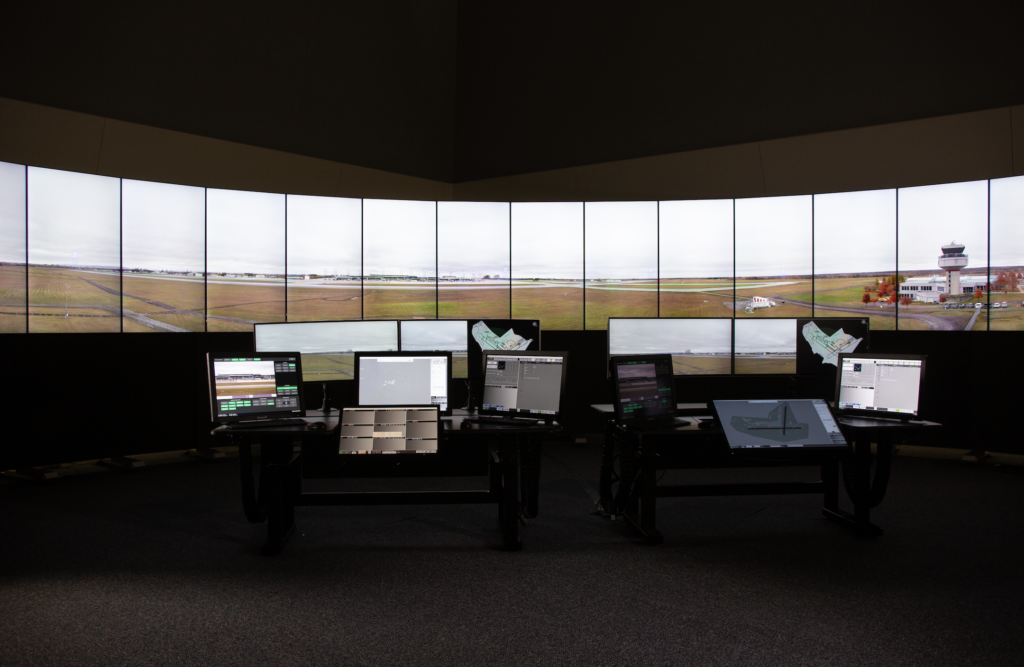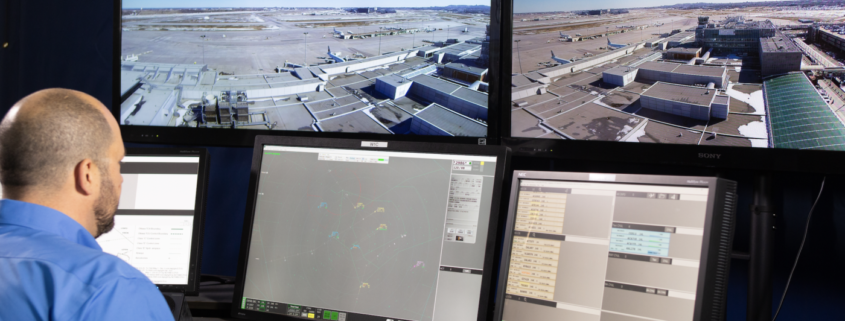Nav Canada tests remote air traffic services
Nav Canada is partnering with Ottawa-based Searidge Technologies in a trial that involves flight service specialists in Saint John, N.B., providing real-time aerodrome advisory services (AAS) to Fredericton International Airport (YFC).
Sitting in a darkened room at Saint John Airport, the flight service station (FSS) specialists peer at three monitors connected to eight cameras installed on the YFC control tower, roughly 100 kilometres (62 miles) away by car.

The trial, which began at the end of June and will continue through December, utilizes six fixed high-definition cameras and two with pre-set zoom capabilities that allow Nav Canada FSS personnel to take a closer look at key areas of the airfield.
The camera equipment and accompanying software were provided by Searidge, which was founded in 2006 and is considered a leader in delivering technical solutions for air traffic control applications, including remote and digital control towers. Its products are currently deployed in 25 countries around the world. Searidge is jointly owned by Nav Canada and the U.K. air navigation services provider, NATS.
For the first time, the use of powerful day-night cameras in Fredericton allows for a visual representation of the airfield, giving remotely-based flight service specialists the ability to provide full aerodrome advisory services, including the ability to direct vehicle traffic on the ground.
Previously, when the Fredericton control tower closed each evening, Saint John-based FSS specialists provided local weather and airport information via a specific radio frequency. This type of arrangement – common across the country at facilities where air traffic levels do not support full onsite services – is referred to as RAAS, or Remote Aerodrome Advisory Services.
While the RAAS system functions well, it has some limitations. For example, there is no actual visual representation of the field, so FSS personnel cannot control ground vehicle movement for things like runway checks.
“By adding a representation of the field with cameras and a remote system, we have real-time contact with the field,” explained Jérôme Gagnon, general manager for Nav Canada’s Montreal Flight Information Region and program director for Digital Facilities.
He added that the trial only applies to providing AAS to Fredericton during the midnight shift. During the day, the Fredericton control tower is in full operation.
Although Nav Canada has installed Searidge camera systems at other Canadian airports, they have so far served only to augment the view of onsite air traffic controllers and FSS personnel.
“The idea was to start using these cameras as support,” said Gagnon. “Let’s say you have a tower and that tower is static. After a while, due to other buildings and different aircraft requirements, we were adding cameras on specific sites just to improve the visibility of controllers and FSS.”
Both Nav Canada and Transport Canada, which approved the Fredericton trial, are particularly interested in evaluating how the cameras perform in all types of weather. Gagnon said it’s an ongoing process to monitor the results, but Nav Canada expects to issue a final report to Transport Canada about two months after the trial ends.
“We see a lot of possibilities,” he said. “The trial will give us more insight into what we can do in the future. One example would be to improve situational awareness by deploying them (the cameras) at certain RAAS locations.”
Safety and efficiency
Nav Canada says the remote AAS technology will allow it to respond quickly to changing service needs. Gagnon gave the example of a flight school moving to an airport with no existing Nav Canada services.

“One thing that might be possible is that maybe we can establish that type of service remotely and adjust quickly to demand. I would say that for this type of service, the sky is the limit with digital facilities.”
Nav Canada is also working with Transport Canada to initiate another trial in Red Deer, Alta., which will involve 46 cameras mounted on a total of four masts, including two with a 360-degree view of the airfield. FSS specialists will have 14 monitors on a video wall, which will display the data tag of each aircraft alongside its icon.
While Gagnon said this technology may allow Nav Canada to “group some FSS or ATC [air traffic control] sites at some point,” it would be “premature to speculate on the resulting staffing efficiencies.”
The goal, he added, is to improve both safety and efficiency in the provision of air traffic services across the country.
“It’s a clear gain from a safety standpoint. We already had a situation where we picked up an aircraft that was supposed to hold short on the runway but didn’t – we were able to pick that up and advise traffic accordingly. Also, in all seasons, we can see fog and weather coming in. With apron lights reflecting on the low cloud situation, we can see that clearly on the weather camera at night.”
Jean-Sébastien Meloche, chief architect at Searidge, told Skies the company has operational systems around the world and knows they work, but the goal of the Fredericton trial is to refine procedures and demonstrate how the camera-augmented RAAS concept of operation can apply to the Canadian ATC market.
“Ultimately, it adds tools for the advisors to do their job,” he concluded.




